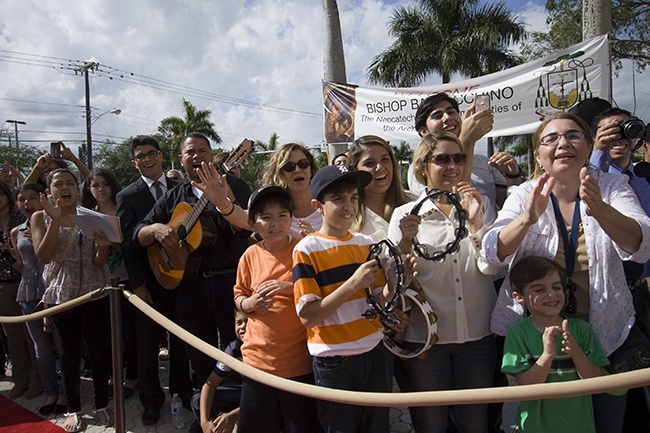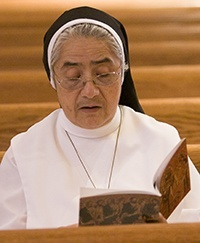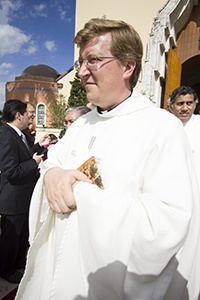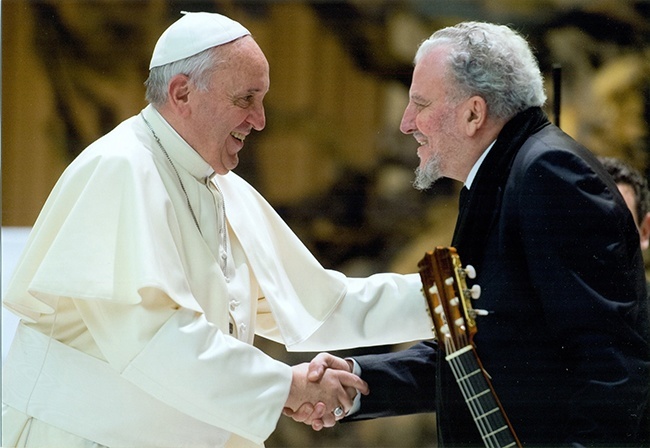By Ana Rodriguez Soto - The Archdiocese of Miami

Photographer: ANA RODRIGUEZ-SOTO | FC
Members of the Neocatechumenal Way sang songs and hung banners in the plaza in front of the cathedral to welcome Bishop Peter Baldacchino to Miami. There are 30 Neocatechumenal communities in the archdiocese, active in eight parishes.
One thing is certain: the Neocatechumenal Way definitely moves people to a new life as Christians.
It is a series of steps � similar to the RCIA, or Rite of Christian Initiation of Adults but lasting much longer � aimed at rekindling the faith in people who have been baptized Catholics.
Miami�s new auxiliary, Bishop Peter Baldacchino, is a product of the Neocatechumenate, which his family joined when he was 13 in his native Malta. He describes the Way as �small communities of rediscovering the faith.�
�Once faith is rediscovered, fruits start to grow. We have seen many fruits,� he said.
- Founders: Kiko Arg�ello, a painter, and Carmen Hernandez, a graduate in chemistry and theology, who met in the shanty town of Palomeras Altas, on the outskirts of Madrid, Spain, and developed a program for evangelizing the slum�s residents, many of them gypsies, prostitutes, drunkards and robbers who had no relationship with the Church.
- 1974: The Congregation for Divine Worship, while preparing the reintroduction of the catechumenate for adults (known as RCIA), publishes a laudatory note, �Praeclarum exemplar,� and settles on the name �Neocatechumenate� to indicate an itinerary of post-baptismal formation for those who are baptized but not sufficiently catechized.
- May 8, 1974: Neocatechumenal Way is approved by Paul VI during a meeting with Arg�ello and Hernandez.
- 1987: John Paul II opens the first Redemptoris Mater seminary in Rome to prepare priests for the New Evangelization; today, there are 100 Redemptoris Mater seminaries worldwide, with almost 2,000 priests already ordained and 2,000 seminarians in formation. Eight of those seminaries are in the U.S., including the one in Miami.
- 1990: Neocatechumenal Way is recognized by John Paul II as �an itinerary of Catholic formation valid for our society and our time,� and an instrument for the New Evangelization.
- June 13, 2008: Five Congregations of the Holy See � Doctrine of the Faith, Divine Worship, Bishops, Catholic Education, and Council of the Laity � approve the final statutes of the Neocatechumenal Way
- Jan. 17, 2011: Pope Benedict XVI approves the �Catechetical Directory of the Neocatechumenal Way.�
- Families in mission: Neocatechumenal Way sends families to areas on the periphery of cities, often immense slums, to form nuclei of evangelization and small communities that can contain the spread of Protestant sects until priests can be sent and new parishes founded. Currently, there are about 1,000 families in mission all over the world.
- Missio ad gentes: Groups consisting of a priest and four or five large families who, at the request of a bishop, receive a mandate to evangelize de-Christianized or pagan areas. There are now 95 missio ad gentes in the world, including six in the U.S. dioceses of Brooklyn, Boston and Philadelphia
- Feb. 1, 2014: Pope Francis, meeting with about 12,000 members of the Neocatechumenal Way, sends 450 families in mission and 42 new missio ad gentes.
- � Today, there are about Neocatechumenal 25,000 communities in 800 dioceses and 6,000 parishes in 124 nations, including 1,000 communities in 300 parishes and 75 U.S. dioceses.
- � The Archdiocese of Miami has 30 communities in eight parishes.
Another �fruit� of the Neocatechumenal Way is an abundance of vocations, because it is a process of formation that encompasses the whole family and attracts young people.

Photographer: ANA RODRIGUEZ-SOTO | FC
Sister Enith Montero of the Dominicans of the Immaculate Conception who work at St. Cecilia Church in Hialeah, looks over the ordination program.
Bishop Baldacchino, a Malta native, is the first bishop in North America to come from a Redemptoris Mater seminary, and only the third such bishop worldwide. One of his classmates, an Italian from Salerno, is vicar general in Estonia.

Photographer: ANA RODRIGUEZ-SOTO | FC
Father Emanuele De Nigris, pastor of St. Cecilia Church in Hialeah, exits the cathedral after the ordination Mass.
The Neocatechumenal Way began in Spain in 1964. Two lay people � Kiko Arg�ello and Carmen Hernandez � developed it as a method of evangelizing the residents of one of Madrid�s poorest slums. Pope John Paul II hailed the Neocatechumenate as �an itinerary of Christian formation valid for our society and for our time.�
�The catechumenate always existed in the Church,� Bishop Baldacchino explained. �It was the instrument the Church used to turn pagans into Christians. It isn�t magic. It is a process that the Church always had.
�I think it was Paul VI who said that we are living in a time of a new form of paganism, a neo-paganism. And he saw paganism, catechumenate, Christianity; and therefore, neo-paganism, neo-catechumenate, new Christian.�
The Neocatechumenal Way fits perfectly with the need for the �new evangelization� that Pope John Paul II described: Not so much bringing Christ to a world that never knew him, as helping nominally baptized Christians � or cultural Catholics � rediscover the fullness of the Christian faith, and live accordingly.
Sister Enith Montero, a Dominican of the Immaculate Conception who has worked at St. Cecilia Church in Hialeah for many years, said she, too, has seen the fruits of the Way.
The parish closed in 2009 for financial reasons, and re-opened in December 2011 with Father Emanuele De Nigris as pastor. Father De Nigris, a native of Italy, is the product of the Redemptoris Mater seminary in Washington, D.C., and serves as rector of the Redemptoris Mater seminary in Miami, which is based at St. Cecilia.
�It has been transformed,� Sister Montero said of the parish. �From the ashes, now it has life in abundance, a community that is very much alive and committed.�
It�s not comparable to what it was before, she stressed, because the community also was �very active, had many (spiritual) groups,� when she served as director of religious education. �It simply is different.�
Her co-worker, Sister Maria Teresa Flores, put it this way: �There are new people and above all young people, young people who hunger for God.�
�These two new priests have raised the community from the ashes,� Sister Montero said. �It�s a new Pentecost.�

Photographer: COURTESY PHOTO | Neocatechumenal Way
Pope Francis meets with Kiko Arguello, co-founder of the Neocatechumenal Way, during a meeting with more than 10,000 members of the group in the Vatican this past February.


Comments from readers
Blessing to you in your new role. Elaine Fowler-Ray, executive director of CVIF
We send our prayers and best regards to Bishop Peter, the clergy and community of Miami. Greetings from Malta.
Louis and Mary Borg.